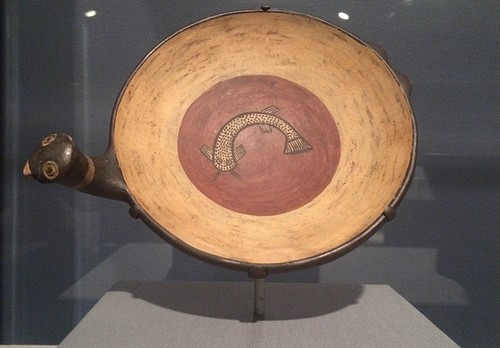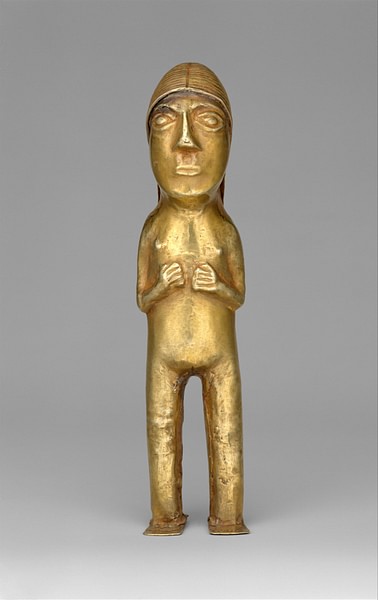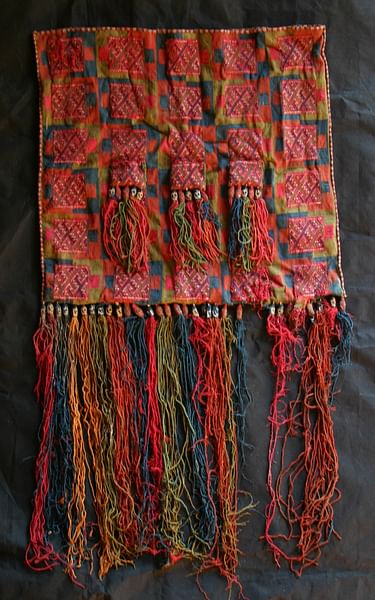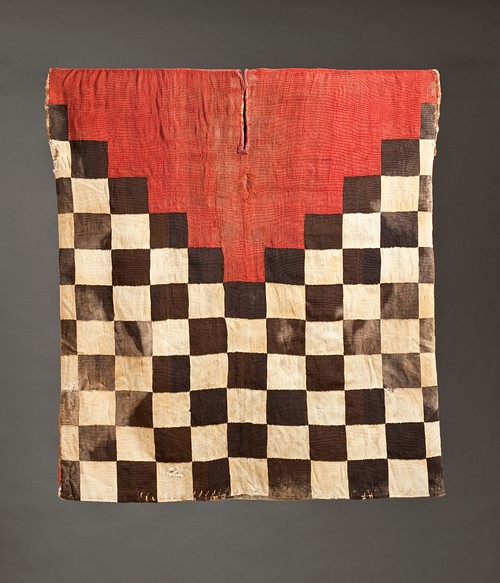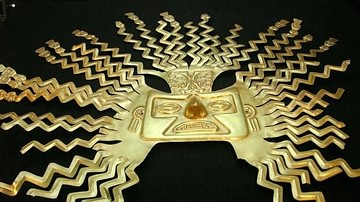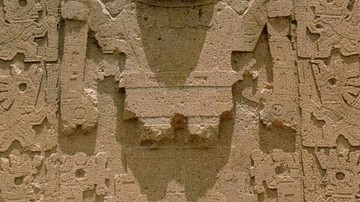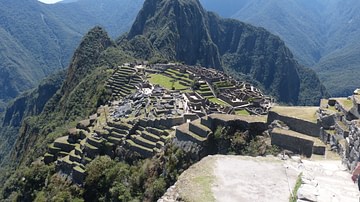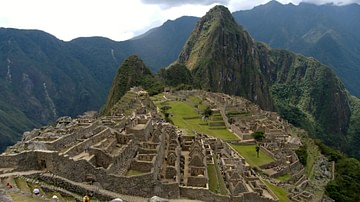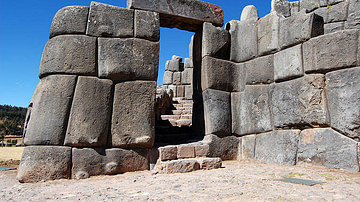
The art of the Inca civilization of Peru (c. 1425-1532 CE) produced some of the finest works ever crafted in the ancient Americas. Inca art is best seen in highly polished metalwork, ceramics, and, above all, textiles, which was considered the most prestigious of art forms by the Incas themselves.
Designs in Inca art often use geometrical shapes, are standardized, and technically accomplished. The European invaders destroyed much of Inca art either for sheer monetary gain or religious reasons but enough examples survive as testimony to the magnificent range and skills of Inca artists.
Influences & Designs
Although influenced by the art and techniques of the earlier Chimu civilization, the Incas did create their own distinctive style which was an instantly recognisable symbol of imperial dominance across their massive empire. The Incas would go on to produce textiles, ceramics, and metal sculpture technically superior to any previous Andean culture, and this despite stiff competition from such masters of metalwork as the craftsmen of the Moche civilization.
Just as the Incas imposed a political dominance over their conquered subjects, so too with art, they imposed standard Inca forms and designs. The art itself did not suffer as a consequence, though. As art historian Rebecca Stone puts it,
Standardisation, though powerfully unifying, did not necessarily lower the quality of art; technically Inca tapestry, large-scale ceramic vessels, mortar-less masonry, and miniature metal sculptures are unsurpassed. (Art of the Andes, 194)
The checkerboard stands out as a very popular design. One of the reasons for the repetition of designs was that pottery and textiles were often produced for the state as a tax, and so artworks were representative of specific communities and their cultural heritage. Just as today coins and stamps reflect a nation's history, so too, Andean artwork offered recognisable motifs which either represented the specific communities making them or the imposed designs of the ruling Inca class ordering them. The Incas did, though, allow local traditions to maintain their preferred colours and proportions. In addition, gifted artists such as those from Chan Chan or the Titicaca area and women particularly skilled at weaving were brought to Cuzco so that they could produce beautiful things for the Inca rulers.
It is also notable that both Inca pottery decoration and textiles did not include representations of themselves, their rituals, their military conquests, or such common Andean images as monsters and half-human, half-animal figures. Rather, the Incas almost always preferred colourful geometrical designs and abstract motifs representing animals and birds.
Ceramics
Inca pottery used natural clay but added such materials as mica, sand, pulverised rock, and shell which prevented cracking during the firing process. There was no potter's wheel in the ancient Americas and so vessels were made by hand, first creating a base and then laying a coil of clay around it until the vessel reached the size required. Then the sides were smoothed using a flat stone. Smaller and medium-sized vessels were made using clay moulds. Before firing, a clay 'slip' was added and the vessel was painted, incised (sometimes using stamps), or had reliefs added. In kilns, pits, or open fires, the vessel was then fired using the oxidising method (adding oxygen to the flames) to create red, yellow and cream coloured pottery, or, via the reduction method (limiting the oxygen supply) to produce black wares.
Ceramics were for wider use, and so forms were, above all, practical. The most common shape was the urpu, a bulbous vessel used for storing maize with a long neck, flared lip, two small handles low on the pot, and a pointed base. The point at the base pressed into the ground and stabilised the pot while maize was poured into it. There were standardized sizes of urpu based on their content volume. They were decorated with abstract plant motifs and geometrical designs, most commonly zig-zags and dots. Examples from Cuzco are more elegant than those from other regions and are painted a distinctive black on red.
Other types of ceramics are large flat serving dishes with animal figure handles, bowls, tall qeros beakers (made in pairs and also in wood), and the paccha. The latter was a hollow tube in the shape of a foot plough, typically decorated with three-dimensional additions such as a corn cob and urpu. The paccha (meaning 'waterfall') was placed into the ground so that maize beer could be ritually poured into it in ceremonies to promote a good harvest.
Metalwork
Objects using precious metals such as discs, jewellery, figurines, ceremonial knives (tumi), lime dippers, and everyday objects were made exclusively for Inca nobles. Gold was considered the sweat of the sun, and silver was considered the tears of the moon. Copper was another popular material, and these metals would have been inlaid with precious stones such as emeralds, polished semi-precious stones like lapis lazuli, polished bone, and spondylus shell. Alternatively, gold and silver were inlaid into bronze. Metals were alloyed, cast, beaten, incised, embossed, beaded, and used as gilding. Inca jewellery pieces made from precious metals included earrings, earspools, pendants, bracelets, and dress pins.
The Inca royalty only drank from gold and silver beakers, and their shoes had silver soles. Surviving figurines, both of humans and llamas, found in burial sites were made either by cast or with up to 18 separate sheets of gold and carved in intricate life-like detail. Gold and silver were also used for many religious pieces, especially representations of natural phenomena and places the Incas held sacred. These works represented the sun, moon, stars, rainbows, lightning, waterfalls, and so on. Masks representing the principal gods such as Inti the god of the sun and Mama Kilya the goddess of the moon, along with other sacred objects, were then placed within Inca temples but these have since been lost.
Perhaps the most famously lost Inca art piece is a gold statue of Inti, represented as a small seated boy and known as Punchao, which was kept in the Temple of the Sun, at the Coricancha (Qorikancha) sacred complex at Cuzco. With rays projecting from his head and decorated with gold jewellery, the stomach of this figure was used as a receptacle for the ashes of the burned vital organs of previous Inca kings. Each day the statue was brought outside of the temple to bask in the sun. Following the Spanish conquest the figure was removed and hidden, never to be found again.
The Coricancha also had a stunning garden dedicated to Inti. Everything in it was made of gold and silver. A large field of corn and life-size models of shepherds, llamas, jaguars, guinea pigs, monkeys, birds and even butterflies and insects were all crafted in precious metal. All that survives of these wonders are a few golden corn stalks, a convincing, if silent, testimony to the lost treasures of Inca metalworkers.
Textiles
Although very few examples of Inca textiles survive from the heartland of the empire, we do have, thanks to the dryness of the Andean environment, many textile examples from the highlands and mountain burial sites. In addition, Spanish chroniclers often made drawings of textile designs and clothing so that we have a reasonable picture of the varieties in use. Consequently, we have many more examples of textiles than other crafts such as ceramics and metalwork.
For the Incas, finely worked and highly decorative textiles came to symbolize both wealth and status. Fine cloth could be used as both a tax and currency, and the very best textiles became amongst the most prized of all possessions, even more precious than gold or silver. Inca weavers were technically the most accomplished the Americas had ever seen and, with up to 120 wefts per centimetre, the best fabrics were considered the most precious gifts of all. As a result, when the Spanish arrived in the early 16th century CE, it was textiles and not metal goods which were given in welcome to these visitors from another world.
It seems that both men and women created textiles, but it was a skill women of all classes were expected to be accomplished at. At the capital Cuzco, the finest cloth was made by male specialists known as qumpicamayocs or 'keepers of the fine cloth'. The principal equipment was the backstrap loom for smaller pieces and either the horizontal single-heddle loom or vertical loom with four poles for larger pieces. Spinning was done with a drop spindle, typically in ceramic or wood. Inca textiles were made using cotton (especially on the coast and in the eastern lowlands) or llama, alpaca, and vicuña wool (more common in the highlands) which can be exceptionally fine. Goods made using the super-soft vicuña wool were restricted and only the Inca ruler could own vicuña herds. Rougher textiles were also made using maguey fibres.
Besides using dyed strands to weave patterns, other techniques included embroidery, tapestry, mixing different layers of cloth, and painting – either by hand or using wooden stamps. The Incas favoured abstract geometric designs, especially checkerboard motifs, which repeated patterns (tocapus) across the surface of the cloth. Certain patterns may also have been ideograms. Non-geometrical subjects, often rendered in abstract form, included felines (especially jaguars and pumas), llamas, snakes, birds, sea creatures, and plants. Clothes were simply patterned, commonly with square designs at the waist and fringes and a triangle marking the neck. One such design was the standard military tunic which consisted of a black and white checkerboard design with an inverted red triangle at the neck.
Additional decoration could be added to textile articles in the form of tassels, brocade, feathers, and beads of precious metal or shell. Precious metal threads could also be woven into the cloth itself. As feathers were usually from rare tropical birds and condors, these garments were reserved for the royal family and nobility.
Conclusion
The European invaders in the 16th century CE not only ruthlessly melted down or spirited away any precious Inca goods they found but also attempted to repress elements of Inca art, even banning such trivial objects as the qeros beakers in an attempt to curb drinking habits. Distinctive Inca textile designs such as those connected to royal power were also discouraged but, in defiance, many of the indigenous peoples continued with their artistic traditions. Thanks to this perseverance and continuity, and despite an evolution where designs were blended with elements of colonial art, many traditional Inca designs and motifs survive to this day and are celebrated as such in the ceramics, metalwork, and textiles of modern Peru.
